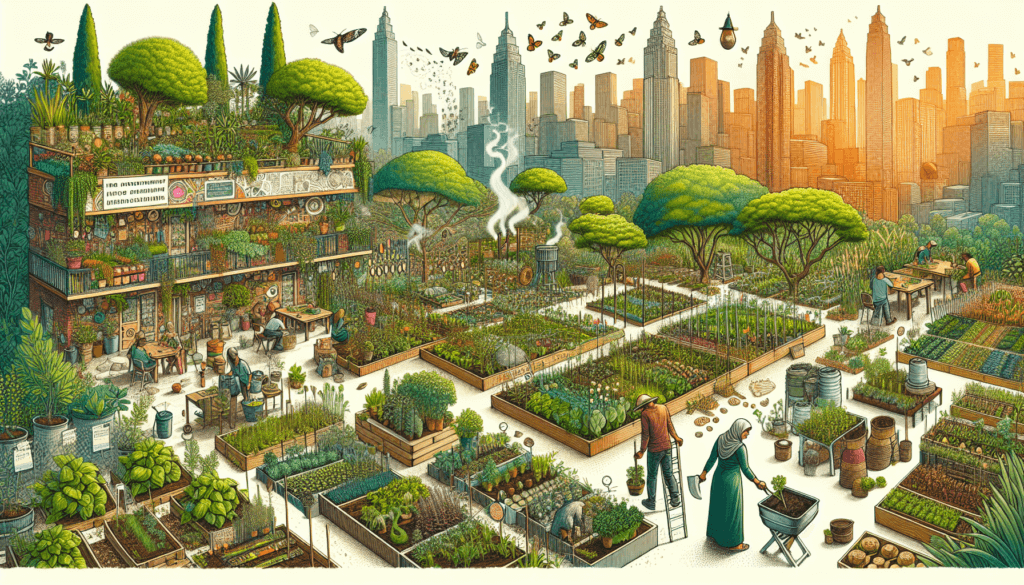Imagine transforming your small urban backyard or rooftop into a thriving garden that not only beautifies your space but also produces a bountiful harvest of fresh, organic fruits, vegetables, and herbs. In this article, learn how to create an urban permaculture garden, a sustainable and self-sufficient system that mimics the natural patterns and processes of an ecosystem. Discover the key principles and techniques that will allow you to create an abundant and resilient oasis in the midst of the city, providing you with a sustainable source of food, a flourishing habitat for wildlife, and a peaceful sanctuary right at your doorstep.

Choosing a Location
When it comes to creating an urban permaculture garden, the first step is choosing the right location. Assessing the available space is crucial, as you want to make sure you have enough area to create your garden. Take into consideration the size of your yard or balcony, and think about how much space you can allocate for the garden. Remember that you can also utilize vertical space by using trellises or hanging baskets.
Another important factor to consider is sunlight and shade. Different plants have different light requirements, so it’s essential to choose a spot that receives adequate sunlight throughout the day. Observe the area during different times of the day to ensure that it gets the right amount of sunshine. Additionally, consider any existing structures or trees that may cast shade on the garden and plan accordingly.
Lastly, evaluating the soil quality is crucial for the success of your urban permaculture garden. Test the soil to determine its pH level and nutrient content. Consider the composition of the soil, whether it’s sandy, loamy, or clay-like, as this will affect drainage and plant growth. If the soil quality is poor, don’t worry. There are various ways to improve it, such as adding compost or organic matter to enrich the soil.
Designing the Garden Layout
Once you have selected a suitable location for your urban permaculture garden, the next step is to design the layout. Creating zones is an effective strategy to maximize space and efficiency. Divide your garden into different areas based on the needs of your plants. For example, group plants with similar sun and water requirements together, and separate those that prefer shade. This will make it easier to manage and maintain your garden in the long run.
Applying permaculture principles will also contribute to the success of your garden. Permaculture focuses on creating a sustainable and self-sufficient system by mimicking the patterns of nature. This approach includes using companion planting to benefit plants, incorporating nutrient cycling, and utilizing natural pest control methods. By applying permaculture principles, you can create a harmonious and productive garden that requires minimal inputs and provides maximum output.
Incorporating vertical gardening techniques is another way to optimize limited space in an urban setting. By utilizing trellises, hanging baskets, or vertical planters, you can grow plants vertically, making the most of your available space. Vertical gardening not only adds visual interest to your garden but also increases productivity by allowing you to grow more plants in a smaller footprint.

Selecting Suitable Plants
Choosing the right plants is essential for a successful urban permaculture garden. Opt for native and edible plants that are well-suited to your local climate and soil conditions. Native plants are adapted to the local ecosystem and require less maintenance, while edible plants provide a source of fresh, homegrown food. Consider the seasonality of the plants as well, selecting varieties that can thrive throughout the year or planning for succession planting.
Incorporating pollinator-friendly plants is crucial for supporting beneficial insects and ensuring the health of your garden ecosystem. Bees, butterflies, and other pollinators play a vital role in plant reproduction, and by providing them with a diverse range of nectar-rich flowers, you can attract and support these valuable creatures. Choose plants that bloom at different times of the year to provide a constant food source for pollinators.
Opting for perennial crops is another wise choice for an urban permaculture garden. Perennial plants come back year after year, saving you time and effort in replanting. They also have deep root systems that contribute to soil health and can withstand harsh weather conditions. Consider incorporating perennial herbs, fruit trees, and berry bushes into your garden for a long-lasting and productive landscape.
Implementing Water Management Strategies
Water management is a crucial aspect of maintaining an urban permaculture garden. By implementing efficient strategies, you can minimize water waste and ensure that your plants receive the necessary moisture. One strategy is capturing rainwater. Install rain barrels or cisterns to collect rainwater from your roof, which can then be used to irrigate your garden during dry periods. Rainwater is free, naturally filtered, and does not contain the chemicals found in tap water, making it an eco-friendly choice.
Designing efficient irrigation systems is also key to water management in an urban garden. Drip irrigation systems deliver water directly to the root zone of plants, reducing evaporation and ensuring that plants receive a steady supply of water. Consider using timers or moisture sensors to automate irrigation and prevent overwatering. By fine-tuning your irrigation system, you can promote healthy plant growth while conserving water.
Utilizing greywater is another sustainable water management practice. Greywater refers to water used from sinks, showers, or washing machines that can be recycled for irrigation purposes. With the use of a greywater system, you can divert this wastewater to your garden, reducing your overall water consumption. However, it’s important to use non-toxic cleaning products to avoid introducing harmful chemicals to your garden.

Creating Healthy Soil
Building and maintaining healthy soil is crucial for the long-term success of your urban permaculture garden. One way to improve soil fertility is by building compost piles. Composting not only reduces waste but also produces nutrient-rich compost that can be added to your garden beds. Collect kitchen scraps, yard waste, and other organic materials in a compost bin or pile, and periodically turn it to encourage decomposition. Over time, you’ll have a valuable source of organic matter to enrich your soil.
Using organic mulch is another method to improve soil health. Mulch helps conserve moisture, regulate soil temperature, and suppress weed growth. Spread a layer of organic mulch, such as straw, wood chips, or shredded leaves, around your plants to improve soil structure, increase microbial activity, and add nutrients to the soil as it breaks down.
Employing green manure crops is another effective technique for building healthy soil. Green manure, also known as cover crops, are plants that are grown specifically to improve soil fertility. These crops are usually tilled into the soil before flowering, adding organic matter, nitrogen, and other nutrients. Examples of green manure crops include legumes like clover or vetch, which fix nitrogen in the soil, and grasses like rye or oats, which help improve soil structure.
Managing pests and diseases
In any garden, managing pests and diseases is an ongoing challenge. However, in an urban permaculture garden, it’s essential to prioritize organic and sustainable methods for pest control. Practicing companion planting is one such approach. Companion plants are chosen for their ability to repel pests or attract beneficial insects. For example, planting marigolds alongside your vegetables can deter aphids, while attracting ladybugs that feed on these pests.
Introducing beneficial insects is another effective method of pest control in a permaculture garden. Ladybugs, lacewings, and praying mantises are natural predators that can help keep pest populations in check. Create habitats for these beneficial insects by planting nectar-rich flowers they feed on and providing them with shelter, such as insect hotels or hedgerows.
Using organic pest control methods is crucial to maintaining a healthy garden ecosystem. Avoid chemical pesticides and opt for natural alternatives. For example, insecticidal soap made from mild soap and water can be sprayed on plants to control soft-bodied pests like aphids or mites. Neem oil, derived from the neem tree, is also an organic option for controlling a wide range of pests. By nurturing a balanced ecosystem with beneficial insects and using organic pest control methods, you can prevent pest outbreaks and maintain a thriving garden.

Integrating Livestock and Poultry
Incorporating livestock and poultry in your urban permaculture garden can provide additional benefits and opportunities for sustainability. Keeping chickens for egg production can not only provide you with a fresh and local source of eggs but also help with composting and pest control. Chickens can be given kitchen scraps and garden waste, which they will turn into nutrient-rich manure. Additionally, they can scratch and eat pests like slugs and snails, reducing the need for chemical pesticides.
Utilizing rabbits for manure is another way to integrate livestock into your urban permaculture garden. Rabbit manure is high in nitrogen and other nutrients, making it an excellent fertilizer. Rabbits are relatively low maintenance and can be housed in outdoor hutches or provided with a safe space to roam within your garden. Their manure can be added to compost piles or used directly as a fertilizer for your plants.
Integrating bees into your garden can promote pollination and increase fruit and vegetable yields. Beekeeping in urban areas is becoming increasingly popular, thanks to the recognition of bees’ vital role in the ecosystem. Consult with local beekeeping associations or experts to ensure that you meet all the necessary regulations and guidelines for keeping bees in your urban setting. By providing bees with a diverse range of nectar-rich plants and creating a safe habitat, you can contribute to the survival of these important pollinators.
Using Sustainable Materials and Techniques
When creating an urban permaculture garden, it’s important to consider the use of sustainable materials and techniques. Select recycled or reclaimed materials whenever possible. From using recycled wood for raised beds to repurposing old containers as planters, incorporating sustainable materials reduces waste and promotes a circular economy.
Building raised beds using non-toxic materials is another sustainable choice. Raised beds provide better drainage and allow you to control the quality of the soil. Instead of using pressure-treated wood, which contains harmful chemicals, opt for untreated cedar or recycled plastic lumber. These materials are long-lasting, safe for plants, and eco-friendly.
Employing permaculture techniques like no-till gardening is another sustainable practice. No-till gardening involves minimizing or eliminating the use of mechanical tilling, which disrupts soil structure and leads to erosion. Instead, use mulch or cover crops to protect the soil, retain moisture, and improve fertility. No-till gardening helps build healthy soil, conserve water, and reduce the carbon footprint of your garden.

Maintaining and Harvesting the Garden
Maintaining and harvesting your urban permaculture garden is an ongoing process that requires regular monitoring and care. Take the time to observe your plants regularly, inspecting for signs of pests, diseases, or nutrient deficiencies. By catching problems early, you can take proactive steps to address them and prevent further damage.
Pruning and harvesting techniques are also important for the health and productivity of your plants. Prune your fruit trees and bushes during the dormant season to encourage proper growth and remove any diseased or damaged branches. When it comes to harvesting, make sure to harvest your plants at the right time to maximize flavor and quality. Different plants have different ripening cues, so do some research on when to pick your crops, ensuring to handle them gently to avoid bruising or damage.
Preserving surplus produce is another way to make the most of your urban permaculture garden. If you have an abundance of fruits or vegetables, consider canning, freezing, or dehydrating them for future use. By preserving your harvest, you can enjoy the flavors of your garden year-round and reduce food waste.
Educating and Engaging the Community
Creating an urban permaculture garden is not only about personal enjoyment but also an opportunity to educate and engage with the community. Organizing workshops and events can inspire others to start their own gardens and teach them about sustainable gardening practices. Share your knowledge and experiences with others, whether through informal conversations or more formal presentations. By fostering a sense of community and collaboration, you can create a network of like-minded individuals who can learn from and support each other.
Creating community gardens is another way to engage the community and promote sustainable urban living. Collaborate with neighbors, local schools, or community organizations to establish shared garden spaces where individuals can grow their own food and learn from one another. Community gardens provide a space for people to connect with nature, improve their food security, and build social bonds.
Sharing knowledge and resources is also a valuable way to engage the community in urban permaculture gardening. Whether through online platforms, social media groups, or neighborhood gatherings, encourage the exchange of tips, ideas, and surplus produce. By fostering a culture of sharing, you can create a supportive and vibrant community of urban gardeners who are committed to sustainability and resilience.
In conclusion, creating an urban permaculture garden requires careful planning, thoughtful design, and ongoing maintenance. By choosing a suitable location, designing an efficient layout, selecting the right plants, implementing water management strategies, building healthy soil, managing pests and diseases, integrating livestock and poultry, using sustainable materials and techniques, maintaining and harvesting with care, and engaging the community, you can create a thriving and sustainable urban garden that not only provides you with fresh food and a beautiful outdoor space but also contributes to the health of the environment and the well-being of your community. So roll up your sleeves, grab your gardening tools, and get started on your urban permaculture journey. Your garden awaits!


